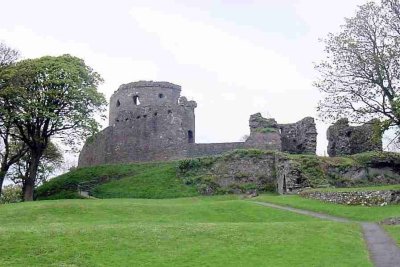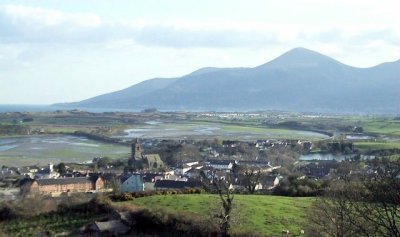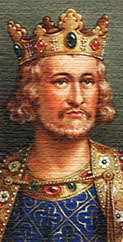 John de Courcy, following his invasion of Ulster in 1177, founded Dundrum Castle. The castle, built to control access into Lecale from the west and south, stands on the top of a rocky hill commanding fine views south over Dundrum Bay and the Mourne Mountains, the lands west towards Slieve Croob and the plains of Lecale to the east. De Courcy's original castle may have had defences of earth and timber, but it is probable that the stone curtain wall of the upper ward was built as early as the 1180s. As with other early enclosure walls, there were no towers, but defence was assisted by covered walks along the outside wall-head. An early timber hall may have been sited near the keep, where there is a double-latrine in the curtain wall.
John de Courcy, following his invasion of Ulster in 1177, founded Dundrum Castle. The castle, built to control access into Lecale from the west and south, stands on the top of a rocky hill commanding fine views south over Dundrum Bay and the Mourne Mountains, the lands west towards Slieve Croob and the plains of Lecale to the east. De Courcy's original castle may have had defences of earth and timber, but it is probable that the stone curtain wall of the upper ward was built as early as the 1180s. As with other early enclosure walls, there were no towers, but defence was assisted by covered walks along the outside wall-head. An early timber hall may have been sited near the keep, where there is a double-latrine in the curtain wall.

In 1204 de Courcy was expelled from Ulster by Hugh de Lacy who strengthened the castle with a massive round keep, probably employing master masons from the Welsh Marches, where such keeps were then popular. Although much of the second floor of this keep was rebuilt in the fifteenth century, it is clear from the survival of the old fireplace flue and spiral stair that it originally stood at least three storeys high. The basement was used for storage and had a cistern below the first floor, which appears to have been the great chamber for the lord's day-to-day living, while the floor above would have housed his private chamber.
 The castle was captured by King John in 1210 and remained Crown property until de Lacy was allowed to return to his Earldom in 1226. It was probably during de Lacy's second tenure as Earl of Ulster (1227-43) that the twin-towered gatehouse, similar to the one at Pembroke Castle, was inserted in the curtain wall. It has a lopsided design with only one projecting tower to protect the approach along a narrow ramp from the south-west
The castle was captured by King John in 1210 and remained Crown property until de Lacy was allowed to return to his Earldom in 1226. It was probably during de Lacy's second tenure as Earl of Ulster (1227-43) that the twin-towered gatehouse, similar to the one at Pembroke Castle, was inserted in the curtain wall. It has a lopsided design with only one projecting tower to protect the approach along a narrow ramp from the south-west
The stone curtain wall of the outer bailey is likely to have been built by the Maginnis family, who seized Dundrum in the late fourteenth century and held it intermittently until finally expelled by Lord Mountjoy in 1601. It was made over to Lord Cromwell in 1605 and sold to Sir Francis Blundell in 1636. The Maginnis family retrieved Dundrum in 1642, but later lost it to the Parliamentarians, who dismantled the castle in 1652 after they withdrew their garrison.
After 1660 the Blundells returned and built a gabled L-shaped mansion in the south-west corner of the outer bailey. This dwelling was ruined by the time the property passed to the second Marquess of Downshire in the early nineteenth century, though the trees on the hill were probably planted at this time. The castle and grounds were placed in State Care by the seventh Marquess in 1954.
The castle is open from April to September; other times by request.
A small admission fee is charged.
Acknowledgement: Irish Castles by Terence Reeves-Smyth.